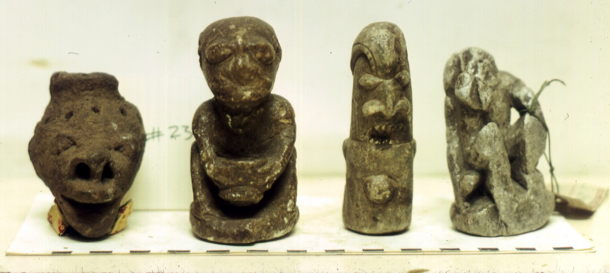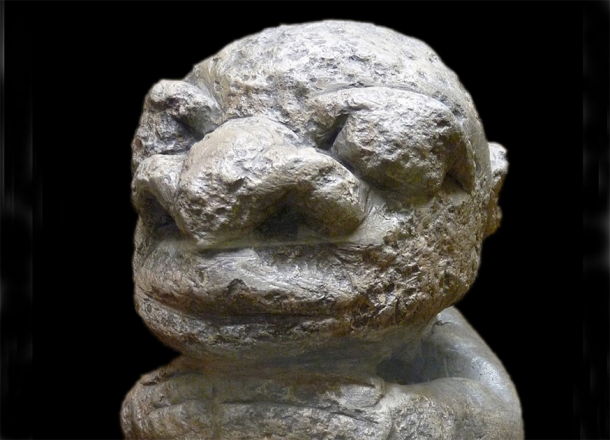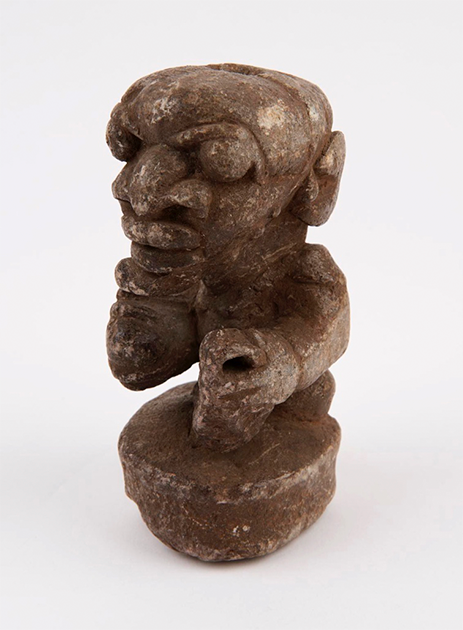Legend has it that the people of Sierra Leone in Africa first uncovered hundreds of extraordinary stone figures while working their land or hunting for diamonds. Discovered underground or within caves, they have come to be known as Nomoli figures.
Despite being known to Africanists, there is little information about the true origins and purpose of these enigmatic statues. This has paved the way for a plethora of curious conspiracy theories related to extraterrestrial activity and giant reptilian humanoids which suggest that the Nomoli figures date back as far as 19,000 years.

Nomoli figures on display at the British Museum. (John Atherton / CC BY-SA 2.0 )
African Legends Surrounding the Nomoli Figures
The Nomoli figures form part of multiple ancient legends, particularly in southern Sierra Leone . Some claim that these Nomoli figures were once angels who lived in the Heavens. However, as a consequence of their bad behavior, God punished them by turning them into humans and sending them to Earth.
These enigmatic sculptures are said to have served as a symbolic representations of these fallen angels , a reminder of their banishment from the Heavens and their subsequent life on Earth as humans. Such beliefs demonstrated the deep spiritual and cultural significance of the Nomoli figures, which continue to fascinate and intrigue scholars and enthusiasts alike.
Another legend dictates that the statues represented the former kings and chiefs of the Sierra Leone region, and that the local Temne people would perform ceremonies during which they would treat the stone figures as if they were the ancient leaders. The Temne were eventually displaced from the area when it was invaded by the Mende, and the traditions involving the Nomoli figures were lost.
While this kind of mythology may provide some insight into the origins and purposes of the stone figurines, no single legend has been definitively identified as the source of the Nomoli figures. Today, some natives in Sierra Leone view the statues as the bringers of good luck , intended as guardians. They place the statues in gardens and fields in the hope of bountiful harvests. In some cases, in times of bad harvest, the Nomoli statues are supposedly ritualistically whipped as punishment.

Detail of one of the Nomoli figures at the Royal Museum of Central Africa in Belgium. (Ji-Elle / CC BY-SA 3.0 )
Physical Features of Nomoli Figures from Sierra Leone
There is a great deal of variation in the physical properties and appearance of the many Nomoli statues. Carved from different materials, including soapstone, ivory and granite, some of the Nomoli figures are small, with the larger ones reaching heights of 11 inches (28 cm). They vary in color, from white to yellow, brown or green.
The Nomoli figures are predominantly human, with their features reflecting multiple human races. However, some of the figures are of a semi-human form – hybrids of both humans and animals. In some cases, the statues depict a human body with a lizard head or vice versa.
Other animals represented include elephants, leopards and monkeys. The figures are often disproportioned, with the heads being large compared to the body size. One statue depicts a human figure riding on the back of the elephant, with the human appearing to be much larger in size than his mount.
Is this a representation of ancient African legends of giants, or merely a symbolic depiction of a man riding an elephant with no importance given to their relative size? One of the more common features of the Nomoli figures is that of a large frightening-looking adult figure accompanied by a child.

Carved Nomoli figure from Sierra Leone. (Science Museum / CC BY-NC-SA 4.0 )
“Outrageous” Theories: Mysterious Nomoli Figures & Ancient Aliens
The lack of clear information about the Nomoli figures has inspired a range of conspiracy theories to explain their history. “In fact, some of the claims about these are really outrageous,” explained a baffled Kathy Curnow in an art history lecture posted by the Palmer Museum of Art . Some pseudo-historians have stated that the Nomoli figures date back as far as 17000 BC, hypothesizing they prove the existence of ancient giants or even extraterrestrial contact.
There are even articles which affirm that when one of the statues was cut open, a small, perfectly spherical metal ball was found within, which would have required sophisticated shaping technology as well as the ability to create extremely high melting temperatures.
These researchers have concluded that the metal spheres were made of both chromium and steel, an odd discovery due to the fact that the earliest known production of steel occurred around 2000 BC. If the dating of the statues back to 17000 BC were to be accurate, how would it possible that the creators of the Nomoli statues were using and manipulating steel up to 15,000 years beforehand?
Asserting that the Nomoli figures would have required high melting temperatures for their creation, or that they contained steel manipulated into perfectly spherical balls , these theories have even suggested that they were constructed by a highly advanced past civilization or even ancient aliens . In following this line of speculation, they argue that the discovery raises fascinating inquiries about the origins and intentions behind the construction of the Nomoli statues, including their timeline and significance to their makers.

Left: Nomoli figure with opening containing metal ball. Right: X-ray of statue before it was opened, showing metal ball inside. ( Project Avalon )
You Can’t Date Stone: Problems with Dating the Nomoli Figures
Despite extensive research and scholarly investigation, a definitive explanation for the origins, construction and function of the Nomoli statues remains elusive. Regrettably, the absence of concrete evidence has opened the door for pseudo-historians to proliferate their unverified theories online, leading to a surfeit of misleading information.
Based on stylistic comparisons, archaeologist John Atherton and historian Milan Kalous estimated that the Nomoli figures, which were first mentioned in European accounts in the mid-15th century, actually dated back to about the 7th or 8th century AD. Nevertheless, not everyone agrees on the dating and, if you’re to believe everything you read on the internet, estimates have dated the figures to some time between 500 BC and 17000 BC. As Curnow stressed, “you can’t date stone.”
While the Nomoli figures are varied in shape and type, they have a uniform appearance that indicates a common purpose, which nevertheless remains unknown. Curator Frederick Lamp asserted that the figures were a part of Temne culture and tradition, but that upon invasion by the Mende in the mid 1500s, the tradition was lost as the villages were displaced to other locations.
With so many questions and uncertainties, we may never have definitive answers as to the dating, origins and purpose of the Nomoli figures. For now, they remain a magnificent representation of the ancient African civilizations that preceded those that now live in Sierra Leone.
Top image: A close-up of one of the Nomoli figures at the British Museum. Source: John Atherton / CC BY-SA 2.0
By M R Reese
Related posts:
Views: 0
 RSS Feed
RSS Feed

















 March 18th, 2023
March 18th, 2023  Awake Goy
Awake Goy  Posted in
Posted in  Tags:
Tags: 
















